 |
ROCK CRUSHER | |||||||||||
|
The provision of crushed stone for the construction industry has been characterized for a long time by large, heavy and expensive machines. Crushers have become larger and larger as the demand for stone increased. The tendency has been for the industry to become extremely capital intensive and highly centralized. Many towns no longer have a crusher at all. In spite of the plentiful supply of labour and the decentralized nature of both that labour and the demand for stone, the size of stone crushing operations has continued to increase. One implication of this is that ever greater numbers of heavy haulage vehicles are required to make deliveries. The cost of operating these vehicles is now a significant proportion of the delivered cost of crushed stone. It is not uncommon for the transport cost of delivering a load of crushed stone to a point more than 100 km from the crusher to be more than the price of the stone itself. Faced with a widespread demand for sized stone and the newly emerging (and barely profitable) groups of "hammer and anvil" businesses, New Dawn Engineering looked carefully at this problem to see if it were possible to produce a manually operated machine for making crushed stone in small quantities. Analysis shows that beyond a radius of about 50 Km from a large crusher, an accptable income can be derived from such a small business. The new Rock Crusher successfully makes use of available human resources, provides decentralized employment, breaks stone into pre-determined sizes and does so as close as possible to the point of use, virtually eliminating the cost of transportation. Virtually all income goes to labour. Stone sold in small quantities (part loads) bears a higher price per cubic metre. For instance, ½ a cubic metre of crushed stone delivered 50 Km may cost three times as much per cubic metre as a large load. Double Flywheel Model This machine can also be fitted with a double flywheel as an optional extra. This is to allow for its use in very hot places where exertion for a long time is exhausting. It is also recommended for places where the people usually have a low body weight or lack physical strength. Doubling the flywheel mass allows the equivalent operation to be done at a lower speed. It also allows for the breaking of larger or stronger stone as it will have twice the power if run at the same speed as a single flywheel machine. Operation And Maintenance The Rock Crusher comes fitted with a heavy flywheel with a handle attached to it. Turning the handle causes one of a pair of jaws to move back and forth with tremendous force. Stones are dropped into the top of the jaws. As they are broken into smaller pieces they fall lower down where the jaws are closer together. Eventually the pieces are small enough to fall out of the bottom of the machine. Setting the space between the jaws sets the size of crushed stone produced. Heavy-duty sealed ball and spherical bearings cope with the loads. Output The larger the pieces you want, the higher the throughput. Normally the stone is first broken with a large sledge-hammer to pieces smaller than 150mm x 150mm. The smaller, the better. It takes less effort to break a large stone with a 10 or 14 pound sledge hammer than with the crusher. The machines is best at producing the small stones, which is the most difficult task for a hand held hammer. The large pieces are first crushed to about 40mm and stored in a pile. This can be done with a team of 7 at a rate of about 5 cubic metres per day. This is a size is suitable for railway sleeper beds, drains and 'stone pitching' beside the road. LITE reports they get 0.7 cubic metres of such stone per person per day, using a team of 7 people in one team as optimal. The division of labour is: - 2 people pulling rocks out of the ground or hillside. - 2 people hauling them to the work site. - 3 people operating the Rock Crusher, taking turns at the handle. LITE has been using 2 teams of 7 on one site for several years. They produce about 10 cubic metres of product per day. The organization of labour took time to optimize however they have maintained this level for the past 3 years. When a customer requires, for example, 20mm stone, the 40mm material is re-crushed. This double process is faster and takes less total work than trying to do it all during the initial stage. In some cases, it is best to have one crusher making 40mm stone, then feed that into 2 machines set at 16mm. There are a number of variables taht affect such decisions including the initial size of the rock, the hardness, the desired size and whether the machine has one or two (or more) people operating it. Using quartzite, and setting the jaws to make 25mm pieces, the Rock Crusher can make about 1 litre of crushed stone per minute, or more than ½ a cubic metre per day. Some crews make 1 cubic metre of 25mm stone per day (15 wheelbarrows). It's about 30 to 50 times faster than using a hammer and anvil. To make small stones in the 12mm range it is faster and easier to two more stages at smaller settings. The jaws can be adjusted closer to each other at the top and bottom giving more than 20 sizes of stone. To do this, pull out the top pin on the fixed jaw and move it closer to the swing jaw, and put the pin in again. The top has 3 positions: 150mm, 100mm and 50mm. When using a 100mm setting, a larger proportion of the jaw is used at a time. This reduces wear on the lower portion of the jaws and increases output. It is easier to break the small pieces than the large ones so the machine should be set to do as much work as people can handle. When producing sub-5mm stone for terrazzo floors, the throughput is much lower, but the product has a much higher value. The Rock Crusher is well suited to producing small quantities of different coloured stones for terrazzo floors. Note that a small amount of "crusher dust" is produced at all times. Labour & Income Experience to date shows that operating the machine (only) with a group of 3 people is best. Stones still have to be dug and transported to the machine by additional people ift hey are not crushed at the source. The three take turns on the handle in 15-20 minute shifts. Three or four people having a business in Swaziland or South Africa about 100km from a large scale crusher would share out R100-400 per day (there area lot of variables that affect this figure).
|
Single Flywheel Rock Crusher: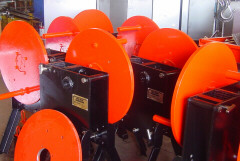 A team of 5 women: 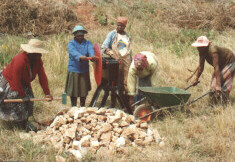 Double Flywheel Rock Crusher: 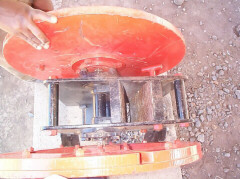 Sekukuneland, Limpopo Prov. RSA: 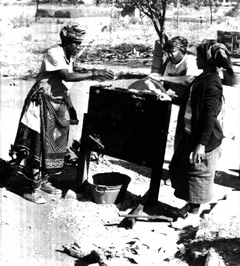 Double Flywheel Rock Crusher, CSIR Project at Lubisi, Eastern Cape Prov. RSA: 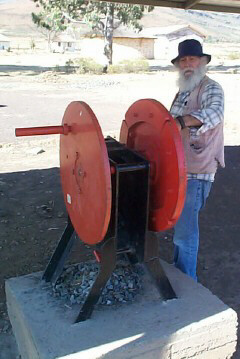 First crush: 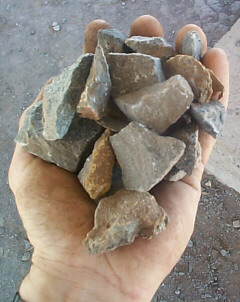 Second crush: 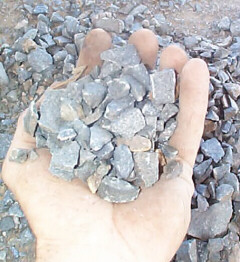 Rock Crusher Instruction Manual: MS Word 97 here (495 KB) RTF here (245 KB) WordPerfect 8 here (1,359 KB) |
|||||||||||
| << Back | ||||||||||||